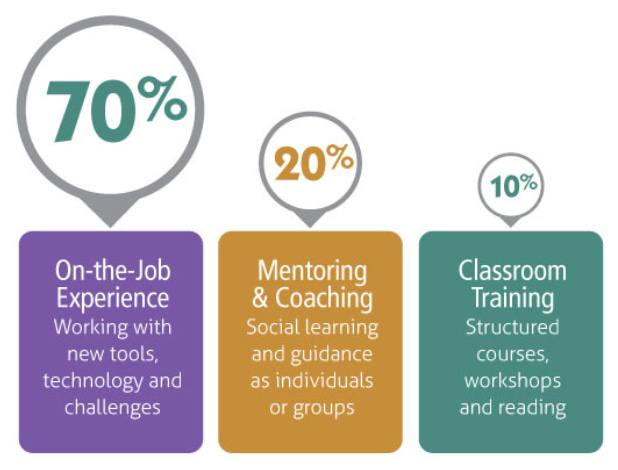Two Birds, One Worm: A Simpler Way to Develop Your People
How inviting your people into your work accelerates their growth—and doesn’t cost you extra time.
If you could develop your people without dedicating a ton of extra time, would you?
That’s today’s topic: less obvious actions that profoundly impact the rate in which your people are developing.
I hope this is a helpful follow up from last week’s 3 questions that shift the ownership of career development from you to your people.
Setting The Stage
A friendly reminder before we dive in…
In the moment, career development often feels like this:
We forget what development actually is:
a series of incremental steps towards greater confidence and competence.
How Did You Become A Badass?
Reflect on your own journey.
How did you learn what you know now?
How did you gain your own level of expertise?
I’m going to dare to assume that you:
Observed excellence
Discussed strategies
Received coaching
Practiced tactics
Would you conclude that ~70% of your own learning and career growth happened on the job?
Precisely.
You’re not alone.
In fact, here’s a Learning & Development framework I’ve leaned into for years:
The Kicker
Here’s the kicker…
We recognize that we largely learn on the job, yet when it comes to developing our people, we tend to think more in terms of trainings, conferences, certifications.
We fail to leverage the very tactic that got us to where we are today.
We fail to capitalize on the on-the-job learning that’s available at our fingertips.
Feed 2 Birds With 1 Worm
Here’s the less obvious way to develop your people:
Involve them in the work.
Let me use 2 real examples to illustrate:
Dan - Influence & Stakeholder Management
I had a team member who identified he wanted to build his skill in driving influence and managing complex stakeholders.
This came at a time when I was kicking off a huge initiative to streamline how product roll outs were communicated.
I was doing the work, and I invited him into the work.
For the kickoff meeting with my stakeholders, I invited Dan. I let the group know why he was there and that he was observing me.
Feed 2 birds with 1 worm.
He took notes on what he saw me do. He wrote down questions about why I did certain things.
In our next 1:1, we debriefed the meeting, his observations, and his notes.
Development happens through conversation. It’s a manager’s job to let them drive, while holding space for the conversation.
He saw, we discussed, he learned, and he practiced implementing the tactics in his own work.
Libby - Project Management
Another team member wanted to learn more about being an effective project manager.
I knew there was a heavy lift of a project kicking off, and I had her join a full workshop with engineering, senior leaders, and other stakeholders.
She got to be in the room where everything was happening.
We then debriefed and discussed her learnings.
Her ah-ha moments?
Collaboration - above all else - matters with project management
Large scale changes don’t happen at the snap of the fingers
Libby was then able to generate her own ideas for how she could hone in on her own approach to collaboration, all in service of her desire to better manage projects.
Intentional observation of work being done + Meaningful discussion = Incremental growth in confidence and competence.
Additional Ways To Invite Them Into The Work
If Dan and Libby’s examples didn’t get your wheels turning enough, consider these development areas and on-the-job development activities:
Decision Making - your team member wants to feel more confident making tough decisions because they notice their people pleasing tendencies can create some indecisiveness, hindering their growth to the next level. The next time you’re facing a complex decision, bring them into the fold. Share the tradeoffs you’re thinking about, ask what decision they’d make in the situation, and their argument for that decision. (It’s highly likely it’s close enough to what you’d decide, and now offer praise for their thinking. You’ve boosted their confidence in decision making.)
Strategic Thinking - your team member has identified they want to pivot from being known for great execution to being someone who is seen for thoughtful strategy. When you do your quarterly goal planning, pull them in. Share the problem you’re solving, how you’re thinking about, and do an exercise of you each drafting org goals and then debriefing on how and why you each made your decisions. You just might get surprised and leverage what they came up with! (Of course give them credit in the process.)
Summary
People development doesn’t have to mean carving out more time.
It’s about using the work in front of you as a tool for growth.
A quick debrief, a peek behind the curtain—that’s where the real development happens.
I’m Katie!
I help leaders drive stronger business results through group training & coaching
I'm also a mom, triathlete, & cowgirl who loves country music and good martinis.
Work with Me
Consider adding me into your career development equation.
Live Group Trainings - perfect for managers looking to increase confidence & competence.
1:1 Leadership Coaching - dial into your leadership competencies & tendencies and gain an effective sounding board and action oriented partner.
Accelerate Your Team’s Performance - leverage data & coaching to align and then accelerate how your team works together and how they deliver results.








